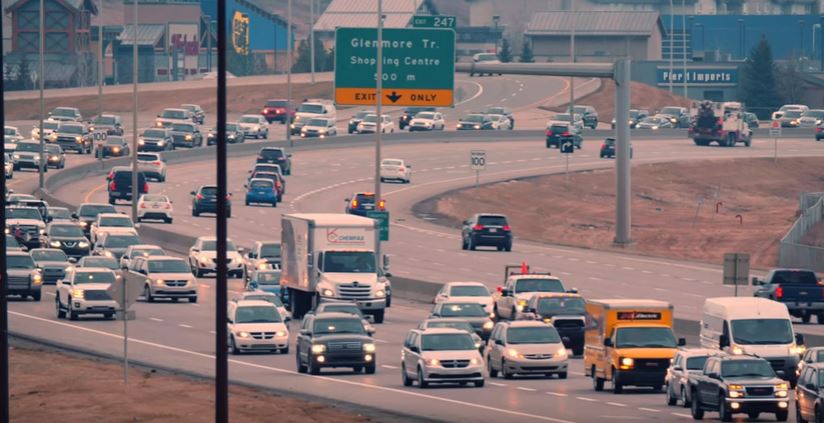A Chat About Calgary Congestion
No matter where you live sitting in congested traffic is frustrating. But how exactly do we stack up to other major cities around the world? Earlier this week INRIX released the 2016 Global Traffic Scorecard that tells a rather interesting story. The study took a comprehensive look at 1,064 cities in 38 countries.
According to the study Calgarians are actually quite well off in comparison to other major urban centres around the world. Here are some of the Calgary stats:
- Calgary drivers spent 15.7 hours in peak hour traffic last year. Calgary ranks 159 th of all cities surveyed for the amount of congestion that driver’s experience.
- Calgary is the 9 th most congested city in Canada behind Montreal, Toronto, St. John’s, Ottawa, Vancouver, Quebec City, Victoria, Edmonton and Hamilton.
View the full scorecard HERE
While this information paints a positive picture on Calgary’s congestion issues, we cannot be complacent on our need to make meaningful investments in our transportation network. A comparative study gives us an idea how we stack up against other cities – it does not suggest we aren’t without problems.
There are a lot of ideas out there on how to tackle congestion issues. Earlier this week I read an interesting article that provided some ideas on how to encourage a more sustainable transportation network: http://driving.ca/auto-news/news/how-it-works-road-congestion-and-design
This article talks about how modern traffic engineering principles can be appropriately applied to address congestion issues. The article states that nearly all experts agree that simply adding new lanes can actually cause more congestion problems. How? It’s called induced demand. Induced demand points to a marked increase in the consumption of a good after supply is increased. If all we do is build roads, all we will likely do is attract more traffic. Adding more capacity on our roadways can be part of a solution, but it cannot be the only action. Adding more lanes to a roadway and expecting congestion to reduce is like buying a larger pair of pants and expecting to lose weight. I’ve tried it – it doesn’t work!
If we really want to see meaningful reductions in congestion we need to establish greater efficiency in our transportation network. This means having robust infrastructure that can stand the test of time, offering diverse transportation options and embracing innovative new approaches to traffic flow management. Calgary is often referred to as an auto-centric city. This characterization is often cited as a negative, but I don’t see it that way. What we need to come to terms with is that providing additional transportation options can enhance the transportation experience for everybody – especially motorists. We must always be mindful that transportation is not about moving trains or buses or vehicles – it’s about moving people. I fundamentally believe that people will choose the path of least resistance to get to where they need to go. That path could be in a vehicle, on a bus, on a bike or even on a train. That diversity of options is critically important.

I talk a lot about the need to improve our public transit infrastructure, but I am also a big proponent of continued investments in our roadways. Let’s look at the current Deerfoot Trail Study as an example. We are looking at some engineering solutions to address some of the pinch points that contribute to some of our congestion issues – that’s great! But that isn’t all we are doing. The study isn’t just about looking for ways to make Deerfoot wider; it’s about finding ways to make Deerfoot better. That means looking into things like real-time digital traffic updates, variable speed limits and high-occupancy vehicle lanes. These are all components that could contribute to ensuring we have a transportation network that is efficient, convenient and safe.
When we think about our congestion issues, we need to look to the future. One of the biggest parts of our future is the Green Line LRT. Green Line LRT offers commuters with a choice. An option like the Green Line could remove significant numbers of vehicles from Deerfoot every day while freeing up road capacity for people still make the decision to drive. That is potential for a significant reduction in congestion without building a single new lane on Deerfoot.
I believe that our existing LRT network has played a big role with how our congestion compares to other major cities. We have one of the highest performing LRT networks in North American and it is certainly the gold standard here in Canada. We designed a network that focused on moving as many as people as possible in a way that was quick, safe and convenient. We made getting the LRT out to where people live a significant priority. The Green Line will double our LRT network and reduce city-wide congestion by 10-15%. That’s a huge win for Calgarians!
Your time is valuable. Time spent stuck in traffic is dead time. It has an economic cost, an environmental cost and it has a cost on your quality of life. As a city we have done a decent job managing our congestion issues, but we still have room to improve. By making strategic investments in our transportation network we can ensure that you get to decide how best to use your time – that’s an idea that I will always support.
